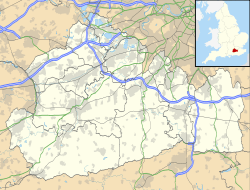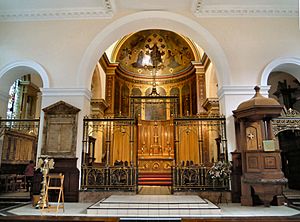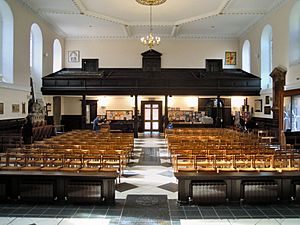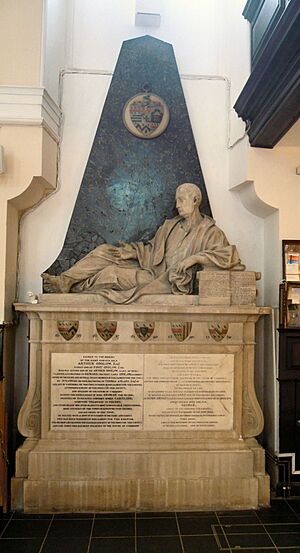Holy Trinity Church, Guildford facts for kids
Quick facts for kids Holy Trinity Church, Guildford |
|
|---|---|
 |
|
| 51°14′09″N 0°34′15″W / 51.235929°N 0.570753°W | |
| Denomination | Church of England |
| Churchmanship | Liberal |
| History | |
| Dedication | Holy Trinity |
| Administration | |
| Deanery | Guildford |
| Archdeaconry | Surrey |
| Diocese | Guildford |
| Province | Canterbury |
Holy Trinity Church is an Anglican church located in the heart of Guildford, England. This large building, made of red brick, was constructed in the early 1760s. It stands where an older, mediaeval church once stood, which sadly collapsed in the mid-1700s.
Holy Trinity is special because it's the only big Georgian church in Surrey. It features beautiful paintings of the Crucifixion and a very large ceiling that doesn't need extra support. The church is also a Grade I listed building, meaning it's very important historically.
From 1927 to 1961, Holy Trinity Church served as the main church for the new Diocese of Guildford. This was before the current cathedral was finished. Today, it's part of the local church community, along with Saint Mary's.
Contents
History of Holy Trinity Church
Building the Church
The first church on this site was a mediaeval building, similar to the nearby Saint Mary's Church. We don't know exactly when it was built, but records show rectors (church leaders) here as far back as 1304. It might have been started by the Normans.
It's believed that King Henry I gave control of the church to Merton Priory. This priory kept control until the time of the Dissolution of the Monasteries, when many religious buildings were taken over by the Crown.
The Weston Chapel

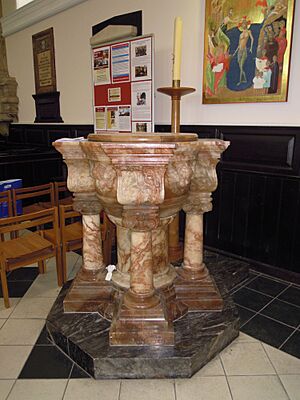
The "Weston Chapel" is a special part of the church, attached to its south side. Its outside walls have a cool checkerboard pattern made of flint and stone. It was built around 1540 by Richard Weston from nearby Sutton Place. He built it mainly as his burial place.
The Weston family remained Catholic even during the Reformation, when England became Protestant. This was a big challenge for them, as it meant they couldn't hold public jobs and were often viewed with suspicion. The Weston family owned the chapel until 2005. Then, they gave it to Holy Trinity Church. As part of the agreement, a Catholic mass is held in the chapel at least once a year.
There are three monuments to the Weston family inside the chapel. One is for Melior Mary Weston, who died in 1782. Another is for Elizabeth Lawson, who died in 1791.
The third Weston monument is a large stone tomb for Anne Pickering, who died in 1582. She was the wife of Sir Francis Weston, who was executed in 1536. Anne wanted to be buried near her first father-in-law. This tomb used to be in the middle of the Weston Chapel but is now in the west porch of the main church.
Church Collapse in 1740
On April 23, 1740, the church's tall steeple fell down. This destroyed most of the building. The only part of that old church that survived is the Weston Chapel. Some outside features, like iron railings and two monuments, also remain.
A new red brick church was built on the same spot. It was designed by James Horne and opened in 1763. This new church is the only large 18th-century church in Surrey. It stands in an important spot at the top of Guildford's High Street.
In the mid-1800s, the inside of the church was changed a lot. In 1869, the windows were updated. The side galleries, which were like balconies, were removed in 1867. The church was also made larger at the east end in 1886. This created the current choir area, sanctuary, side chapel, and organ room.
The church now feels like one huge room. The main decoration in the apse (the curved part at the east end) shows 'the Presence of the Crucified in the Church of all ages'. This means Jesus on the cross is shown with important figures from both the Jewish and Christian faiths. The lower paintings were done by C. E. Buckeridge in 1889–91. The painting on the ceiling was added later by a different artist, which is why it looks different.
Other changes have happened throughout the 1900s. The metal screen for the choir was added in 1927. The organ has been moved and changed many times, with big updates in 1977 and 1997.
Inside the Church
Inside Holy Trinity, you can find the tomb of George Abbot. He was the Archbishop of Canterbury from 1611 to 1633 and started Abbot's Hospital, which is across the street from the church. There's also a memorial for Arthur Onslow, who was a Speaker of the House of Commons.
The church's pulpit (where the preacher stands) is octagonal and dates back to 1769. It looks like the style of Christopher Wren, a famous architect. It used to be taller so the preacher could see people in the galleries, but it was made shorter in 1869.
The beautiful baptismal font was given in 1910 by Miss Russell to remember her two sisters. It has a red marble bowl and is decorated with cherub heads and leaves.
The church also has a ring of eight bells for change ringing. Four of these bells were made in 1769, and the others were made in 1912.
Holy Trinity as a Pro-Cathedral
In 1927, the diocese of Winchester was divided into three parts because the population in south-east England was growing. Holy Trinity Church was first used as the main church, or pro-cathedral, for the new Diocese of Guildford. However, it was decided that the church was too small for this important role.
So, in 1928, the diocese decided to build a new cathedral. Work began in 1933, but the Second World War caused big delays. The new cathedral wasn't officially opened until 1961, though services had been held in its basement since 1947. During all those years, Holy Trinity Church served as the pro-cathedral.
Holy Trinity Today
Worship and Community
The way people worship at Holy Trinity Church follows the liberal tradition of the Church of England. On Sundays, there are usually two services: a Sung Eucharist and Evensong. Morning Prayer is also said every weekday.
Sunday worship is led by a choir of about forty people. This choir is special because it's a parish church choir that still has an all-boys treble (high voice) section.
Holy Trinity is known as Guildford's civic church. This means important town events happen here, like the installation of a new mayor and the annual Act of Remembrance. The church also hosts many musical events.
The church community of Holy Trinity and Saint Mary's has connections with the Diocese of Highveld in South Africa. A group of church members even traveled to the Highveld in 2008.


